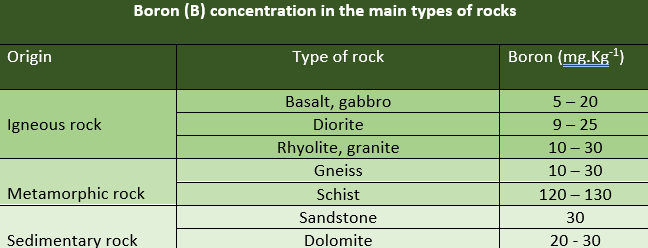Low pH soil (red on the map - Figure 1) is a good indication of boron (B) deficiency. In general, the tropical regions of the world have old and weathered soils with low organic matter. These conditions are favorable to the loss of various nutrients by leaching, especially boron.
Figure 1

In a field study conducted in Brazil, 13,416 soil samples (0-20 cm deep) from 21 Brazilian states were collected and analyzed by the laboratory of the Agronomic Institute of Campinas (IAC). The research concluded that boron (B) is the most deficient micronutrient in Brazilian soils, and zinc (Zn) is the second most deficient micronutrient. According to this study, ~ 89% of Brazilian soils have low or medium levels of boron and ~ 46% of Brazilian soils have low or medium levels of zinc in its composition (Figure 2).
Figure 2
Source: Modified from Abreu et al., 2005.
In another study conducted by Malavolta and Kliemann (1985), in the Brazilian Cerrado region (Figure 3), 528 soil samples (0-15 cm deep) were analyzed in the lab, and ~ 60% of these samples presented extremely low boron contents (< 0.2 mg/dm-3 of B).
Figure 3
Source: worldatlas.com
The availability of boron in Brazilian soils occurs in a very heterogeneous way. For instance, in the state of Parana, the presence of higher boron content in the soil coincides with the presence of sedimentary and metamorphic rocks and the lower content of boron coincides with the presence of igneous rock (Figures 4 and 5).
Figure 4
Source: Mineropar, Levantamento Geoquimico Multielementar do Estado do Parana.
Figure 5. Boron in the main types of rocks

Source: Adapated from Kabata-Pendias & Pendias (1992)
Soil analysis interpretation
The table below from the
AGRONOMIC INSTITUTE OF CAMPINAS (IAC), classifies boron availability soil. These classes are listed in the publication
BOLETIM 100, considered the most current publication.
The classes are segmented for annual and perennial crops:
Availability classes for boron in soil: Annual crops
| Availability class |
B (hot water)
mg/dm3 |
| Low |
<0.2 |
| Medium |
0.2-0.6 |
| High |
>0.6 |
Availability classes for B in soil: Perennial crops
| Availability class |
B (hot water)
mg/dm3 |
| Low |
<0.6 |
| Medium |
0.6-1.0 |
| High |
>1.0 |
Application timing and method
Apply boron before identifying the deficiency in crops —through soil and crop tissue samples. Boron applications can be carried out at planting and in coverage, depending on the crop. The timing of applications must be adjusted in such a way that they meet the boron needs and the vegetative and reproductive phases—the latter being the most demanding for crops. Field applications can be mechanized or with manual applications.
Boron in the plant
The concentration of boron in plants ranges between 12 and 50 mg kg-1 of dry weight of the tissue. For a good growth of most crops, boron concentrations in the leaf tissue should be between 30 to 50 mg kg-1. Deficient plants exhibit leaf concentrations less than 15 mg kg-1. (Malavolta, 1980; Malavolta et al., 1989; Pais & Jones Junior, 1996; Furlani, 2004).
Extraction and export of boron
| Crop |
Extraction g.t-1 of grain |
Export g.t-1 of grain |
| Soybean |
77 |
22 |
| Corn |
18.3 |
4.4 |
| Wheat |
19.9 |
2.9 |
| Bean |
66.3 |
13.3 |
Source: Adapted from Pauletti, 2004.
Boron fertilizer products
Discuss your boron needs with your local agronomist or contact a regional U.S. Borax expert to determine which product is suitable for your soil and crops.
References
-
Malavolta, E., & Kliemann, H. J. (1985). Nutritional disorders in the Cerrado (p. 136). Piracicaba: Associação Brasileira para Pesquisa da Potassa e do Fosfato.
-
ABREU, C.A.; ABREU, M.F.; van RAIJ, B.; GONZALEZ, A.P. 2025. Routine soil testing to monitor heavy metals and boron. Scientia Agricola 62:564-571.
-
Kabata-Pendias, A., & H. Pendias. 1992. Trace elements in soils and plants. CRC Press, Boca Raton, FL.
-
Cantarella H, Quaggio JA, Mattos Jr. D, et al. 2022. Boletim 100: Recomendações de adubação e calagem para o estado de São Paulo. Instituto Agronômico de Campinas – IAC:490